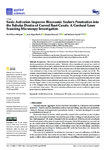Sonic Activation Improves Bioceramic Sealer’s Penetration into the Tubular Dentin of Curved Root Canals: A Confocal Laser Scanning Microscopy Investigation
| dc.contributor.author | Pérez-Alfayate, R | |
| dc.contributor.author | Algar-Pinilla, J | |
| dc.contributor.author | Mercade, M | |
| dc.contributor.author | Foschi, F | |
| dc.date.accessioned | 2022-02-25T13:30:23Z | |
| dc.date.available | 2022-02-25T13:30:23Z | |
| dc.date.issued | 2021-04-26 | |
| dc.identifier.issn | 2076-3417 | |
| dc.identifier.issn | 2076-3417 | |
| dc.identifier.other | 3902 | |
| dc.identifier.uri | http://hdl.handle.net/10026.1/18853 | |
| dc.description.abstract |
<jats:p>Background—The aim was to determine the influence of sonic activation in the tubular dentine penetration of bioceramic sealers. Methods—Forty mesiobuccal curved root canals of mandibular molars with an apical diameter smaller than #30 were prepared, divided into two groups, and filled with EndoSequence BC sealer, with or without sonic activation during its placement. Roots were sectioned at 3 mm, 6 mm, and 9 mm from the apex, producing a sample size of 120. The samples were evaluated using a confocal laser scanning microscope and comparing these images to the images obtained from an operatory microscope. The percentage of sealer penetration and maximum sealer penetration were evaluated. Statistical analysis was performed using the two-tailed Mann–Whitney U test, where statistical significance was set to p < 0.05. Results—Sonic activation showed higher values for the percentage of sealer penetration when compared at the 9 mm level (p = 0.03). A higher value of maximum sealer penetration was observed at all levels when the sealer was activated. Conclusions—The sonic activation of bioceramic cement resulted in higher sealer penetration into dentinal tubules.</jats:p> | |
| dc.format.extent | 3902-3902 | |
| dc.language | en | |
| dc.language.iso | en | |
| dc.publisher | MDPI AG | |
| dc.subject | CLSM | |
| dc.subject | Endoactivator | |
| dc.subject | EndoSequence BC sealer | |
| dc.subject | sonic activation | |
| dc.subject | tubular penetration | |
| dc.title | Sonic Activation Improves Bioceramic Sealer’s Penetration into the Tubular Dentin of Curved Root Canals: A Confocal Laser Scanning Microscopy Investigation | |
| dc.type | journal-article | |
| dc.type | Journal Article | |
| plymouth.author-url | https://www.webofscience.com/api/gateway?GWVersion=2&SrcApp=PARTNER_APP&SrcAuth=LinksAMR&KeyUT=WOS:000649907600001&DestLinkType=FullRecord&DestApp=ALL_WOS&UsrCustomerID=11bb513d99f797142bcfeffcc58ea008 | |
| plymouth.issue | 9 | |
| plymouth.volume | 11 | |
| plymouth.publication-status | Published online | |
| plymouth.journal | Applied Sciences | |
| dc.identifier.doi | 10.3390/app11093902 | |
| plymouth.organisational-group | /Plymouth | |
| plymouth.organisational-group | /Plymouth/Faculty of Health | |
| plymouth.organisational-group | /Plymouth/Faculty of Health/Peninsula Dental School | |
| plymouth.organisational-group | /Plymouth/Users by role | |
| plymouth.organisational-group | /Plymouth/Users by role/Academics | |
| dcterms.dateAccepted | 2021-04-23 | |
| dc.rights.embargodate | 2022-2-26 | |
| dc.identifier.eissn | 2076-3417 | |
| dc.rights.embargoperiod | Not known | |
| rioxxterms.versionofrecord | 10.3390/app11093902 | |
| rioxxterms.licenseref.uri | http://www.rioxx.net/licenses/all-rights-reserved | |
| rioxxterms.licenseref.startdate | 2021-04-26 | |
| rioxxterms.type | Journal Article/Review |


